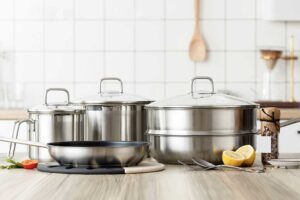
Stainless steel cookware is ubiquitous in modern kitchens, lauded for its robustness and aesthetic appeal. However, the hidden health risks associated with the integral components of stainless steel, namely chromium and nickel, are a growing concern. This comprehensive article aims to unravel risks in Stainless Steel Cookware, presenting in-depth insights into safer alternatives and best practices for health-conscious consumers.
Deep Dive into Stainless Steel: Composition and Concerns
At its essence, stainless steel is an iron-based alloy. Its resistance to corrosion and tarnishing is attributed to the addition of chromium, typically ranging from 10% to 30%. This chromium content is crucial as it forms a passive chromium oxide layer, shielding the underlying metal. In many stainless steel varieties, nickel is also incorporated to enhance the alloy’s formability and strength.
However, the interaction of these metals with food, especially under certain cooking conditions, sparks significant health concerns. Studies reveal that cooking acidic foods or using abrasive cleaning methods can lead to the leaching of chromium and nickel into the food. The potential health implications of this metal leaching, ranging from allergic reactions to more severe chronic conditions, have been the subject of extensive debate among experts.[1][2]
The Health Implications of Chromium and Nickel
The human body requires trace amounts of chromium for glucose metabolism, but excessive intake can pose health hazards. Chromium VI, a carcinogenic form, is of particular concern, although it’s less commonly associated with stainless steel cookware.
On the other hand, nickel, though essential in minuscule amounts for bodily functions like hormone and lipid metabolism, is known for causing dermatitis in sensitive individuals. Long-term exposure to high levels of nickel can lead to more serious health issues, including respiratory problems, heart disorders, and kidney damage.
The risk of metal leaching is influenced by factors such as the cookware’s quality, age, and usage patterns. Frequent cooking of acidic foods, such as tomato sauce or lemon-based dishes, in stainless steel pots and pans can exacerbate this leaching process.[3]
Exploring Safer Stainless Steel Options
Not all stainless steel cookware is created equal regarding health safety. The 18/10 and 300 series stainless steel are considered safer options. The nomenclature 18/10 indicates 18% chromium and 10% nickel, balancing corrosion resistance with minimal metal leaching. The 300 series, especially types 304 and 316, are distinguished by their higher chromium and reduced nickel content, which lowers the likelihood of metal leaching.[4]
These alternative compositions create a more robust protective chromium oxide layer, effectively reducing the amount of metal that can migrate into food. This makes them preferable for those aiming to limit their exposure to these metals.
Best Practices for Stainless Steel Usage in the Kitchen
To minimize potential health risks, specific practices can be adopted:
- Avoid cooking or storing acidic foods in stainless steel, which can accelerate metal leaching.
- Utilize glass or ceramic containers for storing acidic foods. These materials are inert and do not interact with food acids.
- Select wooden, silicone, or plastic utensils to prevent scratching stainless steel surfaces, which can compromise the protective chromium layer.
- Regularly inspect stainless steel cookware for signs of wear and deterioration, which can increase metal leaching risks.
- Consider the age of stainless steel cookware; older pots and pans might be more prone to leaching due to wear and tear.[2]
Carbon Steel: A Notable Alternative
Carbon steel is a noteworthy option for those seeking alternatives to stainless steel. Resembling cast iron in its properties, carbon steel offers superior heat retention and durability but is lighter in weight. Devoid of chromium or nickel, carbon steel is a safer choice for those concerned about metal leaching. However, it requires regular seasoning to maintain its non-stick properties and prevent rust.
Conclusion: A Balanced Approach to Cookware Choices
In conclusion, while stainless steel continues to be a popular choice for cookware, it’s imperative to be cognizant of the potential health risks associated with its use. Consumers can significantly mitigate these risks by opting for safer stainless steel varieties, using inert materials for food storage, and adopting gentle utensils. The ultimate goal is not to eliminate stainless steel from the kitchen but to use it thoughtfully and safely, balancing health considerations with its functional benefits.
References:
- Eliaz, Noam. “Corrosion of Metallic Biomaterials: A Review.” Materials (Basel, Switzerland) vol. 12,3 407. 28 Jan. 2019, doi:10.3390/ma12030407
- Ali Sultan, Saif Ali et al. “Assessing Leaching of Potentially Hazardous Elements from Cookware during Cooking: A Serious Public Health Concern.”




Leave a Reply
Your email is safe with us.